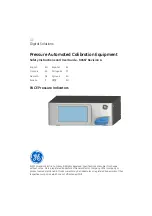
Crestron Isys™
TPS-5000
12 Inch Tilt Touchpanel
at a time, an 'R' code always follows a 'P' code. A fixed three-digit format is used to
simplify software on the host.
Codes may be sent to the touchpanel in the same form as they are received. The 'P'
form turns on a function and the 'R' form turns off a function; sending back
information received from the touchpanel (i.e., jumping pins 2 and 3 on the RS-232
port) makes the buttons momentary. Notice that the touchpanel responds to P and R
commands even when configured for other interface modes. Selecting an RS-232
interface mode merely enables P and R commands to be issued. In addition, the fixed
format is not required for commands sent to the touchpanel; P1, P01, and P001 are
all perfectly valid commands.
Compared to running on Cresnet, an RS-232 interface to a personal computer is
slower, provides less features (such as tracking, among others), is less noise immune
(Cresnet uses balanced transmission for high common mode rejection, RS-232 does
not), and requires the user to supply the control logic program in the PC.
V<chan>,<level> Command
- Levels in gauge and slider objects may be set
through the RS-232 port. The command contains both the object channel number (1-
255) and level (0-65535) in decimal separated by a comma. For example, V6,32768
would set channel 6 to level 128, or half way up.
One quick note on baud rate and smooth ramping. Ramping is accomplished by
sending successive levels to the object. To do this in 64 levels over three seconds, for
example, requires about 576 bytes worth of commands to be sent, and could not be
accomplished at any rate less than 2400 baud. Obviously, ramping several objects at
once requires a baud rate several times as high.
Indirect Text
– TPS-5000 touchpanels support a feature that permits the text field in
any user-defined button to be altered on the fly in RUN mode. This is accomplished
by substituting a text pointer for the text in the button. The text pointer informs the
panel to use the contents of a variable that may be dynamically redefined as the text
field for the button. This presents a considerable advantage over other methods in
that changing screens does not destroy information and that information may be
placed in buttons not currently displayed.
The text pointer is a number in the range of ‘1’ through ‘127’ preceded by the
“pound” symbol (#). If [text…] is omitted, the text field is cleared. If [text…] exists,
it is added to the text field. For example, consider the following string:
#3,Now is the time<cr>
#3,for all good men<cr>
#3,to come to the<cr>
#3,aid of the party<cr>
Assuming that a button with an #3 text pointer was being displayed, the contents of
the button would be changed to:
Now is the time
for all good men
to come to the
aid of the party
NOTE:
To clear the text field for this example, type in “#3<cr>”.
As each line is entered, the display is updated. Since the text may be placed in
several different buttons, no boundary checking is done to see if the text fits in the
button. If the text overflows the button/boundaries, it remains centered in the
button/boundary.
Operations Guide - DOC. 5863A
12 Inch Tilt Touchpanel: Crestron Isys™ TPS-5000
•
45








































